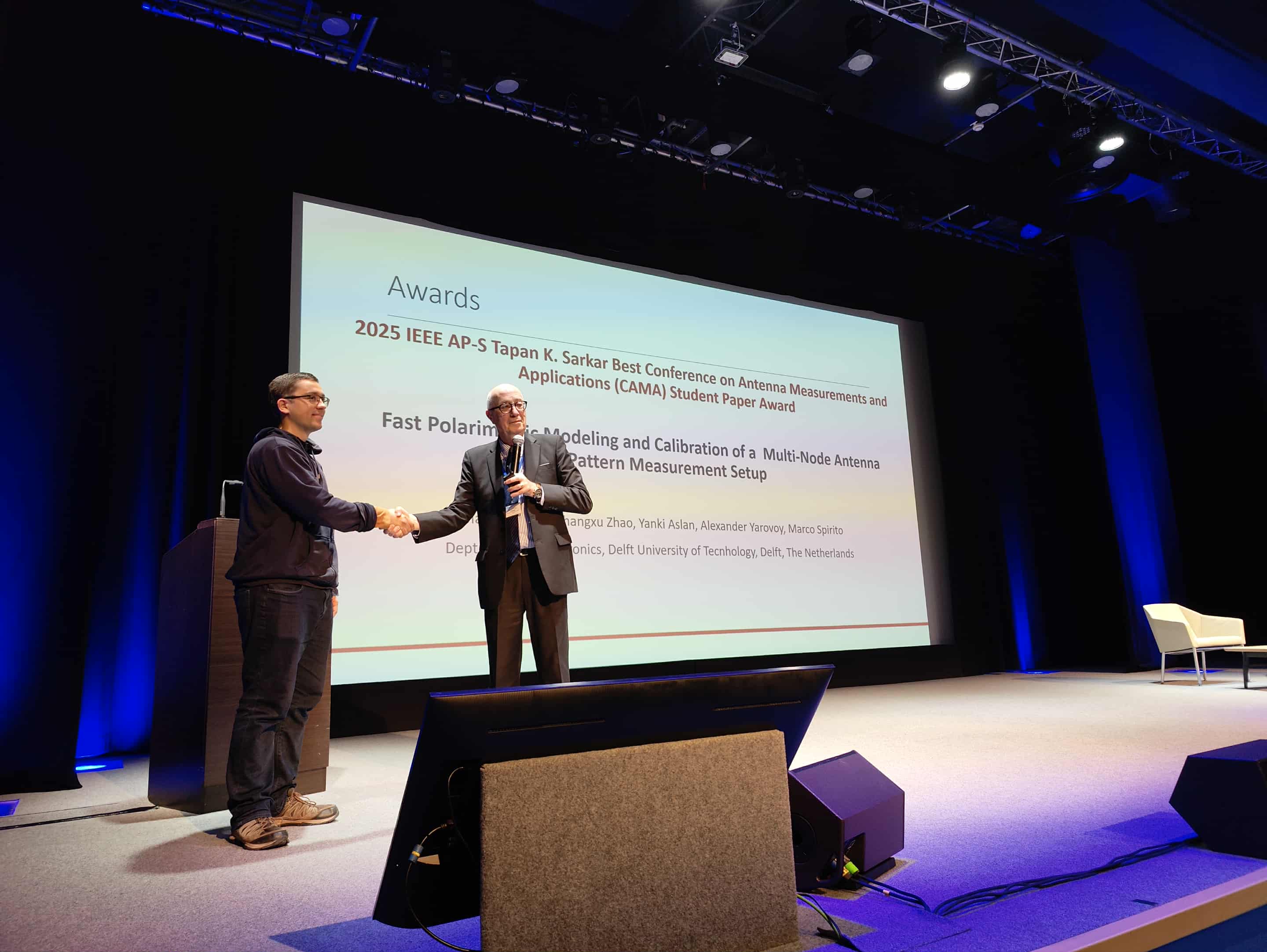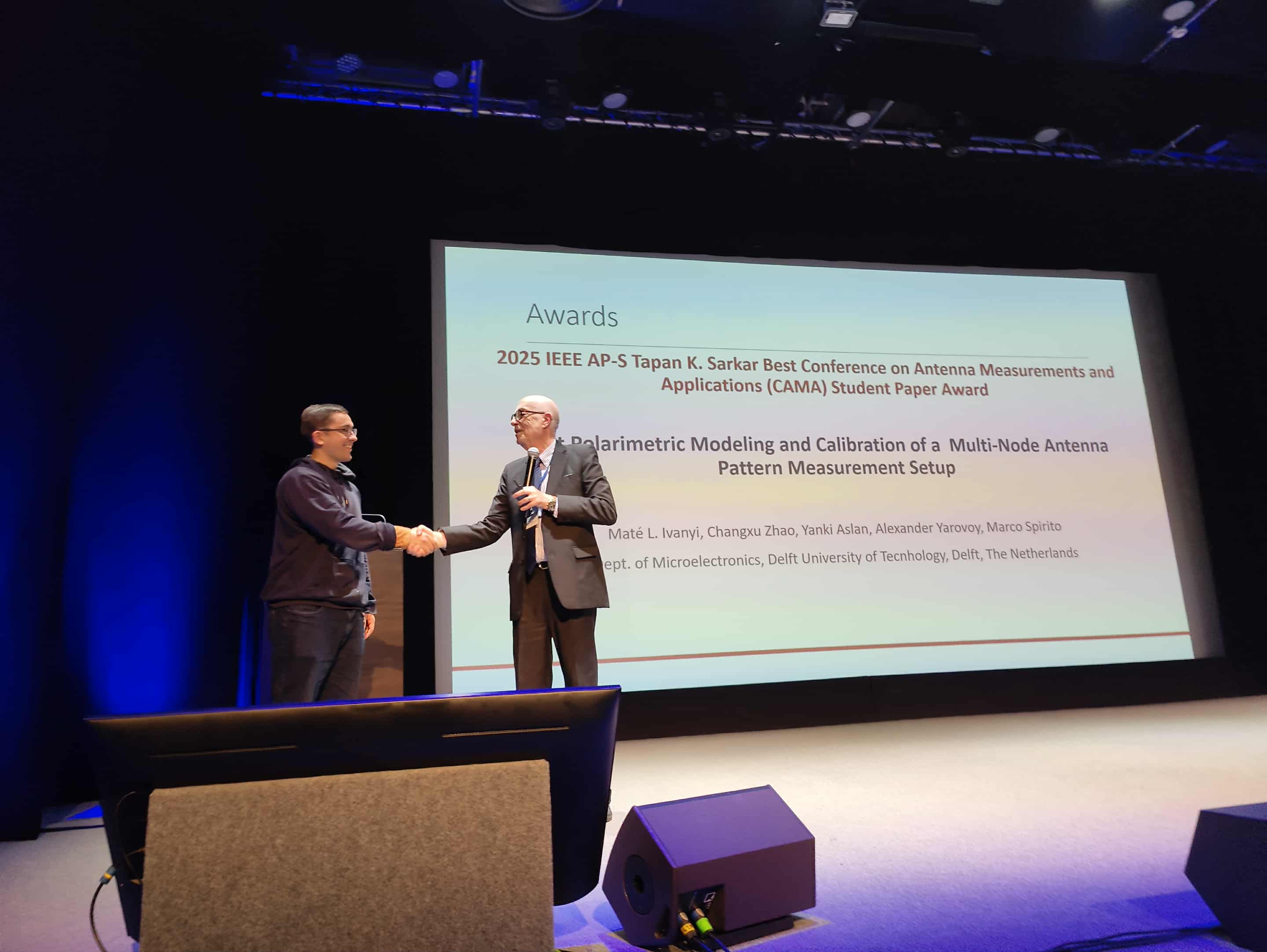News
Best Student Paper Prize at IEEE CAMA 2025
- Friday, 21 November 2025

Best student paper prize at the IEEE International Conference on Antenna Measurements and Applications (IEEE CAMA) for joint MS3-ELCA paper. Congratulations to all the authors!
Title: Fast Polarimetric Modeling and Calibration of a Multi-Node Antenna Pattern Measurement Setup
Authors: Máté L. Iványi, Changxu Zhao, Yanki Aslan, Alexander Yarovoy, Marco Spirito

European Research Council (ERC) awards prestigious Synergy Grant to the DISRUPT team
- Thursday, 6 November 2025
The European Research Council (ERC) has awarded a prestigious Synergy Grant to the DISRUPT project, led by TU Delft, the Netherlands, in partnership with Fraunhofer IAF, Germany, and University College Dublin (UCD), Ireland.
The groundbreaking project has secured nearly €10 million in funding to develop a fully digital RF power architecture that aims to cut the energy consumption of next-generation wireless networks—such as 5G and 6G—by as much as 50 percent.
A total of €684 million in ERC Synergy Grant funding was announced today to support 66 exceptional research teams across Europe and beyond. These competitive grants aim to foster deep collaboration among top researchers, allowing them to pool expertise and resources to tackle the most complex scientific challenges.
“Collaboration is at the heart of the ERC Synergy Grants,” said Professor Maria Leptin, President of the European Research Council. “In our latest round, teams of researchers will join forces to address the most complex scientific problems together - this time, they are more international than ever. The competition was fierce, with many outstanding proposals left unfunded. With more funds, the ERC could fully capitalise on this wealth of first-class science. Such scientific endeavours are what Europe needs to be at the real forefront.”
DISRUPT: A Fully Digital RF Power Paradigm
DISRUPT (Digital RF Power) is an ambitious and transformative research project aiming to address the growing ecological impact of wireless communications. The current carbon footprint of global wireless networks is comparable to that of aviation, accounting for 2–3% of worldwide CO₂ emissions. Without major innovation, this figure is expected to rise sharply as 5G and 6G communication systems continue to scale.
The project brings together four world-leading researchers:
- Prof. Leo de Vreede (TU Delft) – expert in digital transmitter architectures
- Prof. Rüdiger Quay (Fraunhofer IAF and professor at the University of Freiburg) – specialist in GaN semiconductor technology
- Prof. Bogdan Staszewski (UCD) – pioneer in digital PLLs and transceivers
- Prof. Anding Zhu (UCD) – expert in digital predistortion.
This research team is complemented with four highly talented junior scientists to gain even more momentum and handle the workload and complexity of the project adequately, namely: Dr. Morteza Alavi (TU Delft), Dr. Prof. Masoud Babaie (TU Delft), Dr. Chang Gao (TU Delft), and Dr. Thomas Fritzsch (Fraunhofer IZM).
Their shared goal is to develop a revolutionary, fully digital transmitter architecture that replaces the most energy-intensive components in wireless infrastructure: the analog-dominated base stations, which are responsible for over 70% of network energy consumption.
A DISRUPTive Approach to Energy-Efficient Wireless Transmission
The project adopts a radically new approach: co-integrating advanced CMOS (Complementary Metal-Oxide-Semiconductor) with a yet-to-be-developed segmented III-Nitride (III-N) semiconductor platform. This integration will enable a fully digital RF transmitter, built from thousands of ultra-fast, low-threshold III-N FET devices arranged in switch-bank arrays. These devices will be individually controlled with picosecond precision by a CMOS driver layer mounted above via ultra-high-density flip-chip interconnects.
This unique digital structure will enable the direct generation of high-power, wideband, coherent RF signals, with precise control over amplitude and phase. The platform will also pioneer novel energy efficiency enhancement techniques and enable seamless integration of digital signal processing, clock generation, error correction, and AI-based signal optimization.
The DISRUPT project aims to deliver record-breaking digital transmitters for applications in 5G and 6G, and will work closely with industry partners to ensure early-stage technology transfer and long-term societal impact.
The team’s vision is to set a new global benchmark for energy-efficient wireless infrastructure, empowering future mobile networks to meet soaring data demands while minimizing environmental cost.
“Receiving the ERC Synergy Grant is a tremendous recognition of the bold and interdisciplinary vision behind DISRUPT”, Professor Anding Zhu said, “This €10 million grant empowers us to push the frontiers of wireless technology by combining advanced materials science, semiconductor device innovation, and RF system architecture in a truly transformative way.”
Professor Leo de Vreede said, “We are extremely grateful that the ERC council offered this opportunity to realize our DISRUPTive research ideas and, as such, contribute to society. It is like a dream coming true.”
Professor Rüdiger Quay stated, “It is a great honour that with the ERC Synergy Grant, the long-term devotion to deeply scaled RF semiconductor technologies in Europe is recognized. I am thankful to have such capable coworkers both in Freiburg and in DISRUPT”.
Professor Bogdan Staszewski said, “I extend my sincere gratitude to the European Research Council for their confidence in our team’s scientific vision and capabilities. I personally regard this grant as a natural progression of my earlier ERC Starting Grant— now taking on an even greater challenge as we advance our research to radio-frequency power levels thousands of times higher.”
